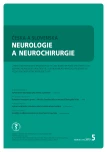Pegylated inteferon beta 1-a in clinical routine
Authors:
E. Němá; J. Libertínová; P. Ročková; M. Petržalka; E. Houžvičková; E. Meluzínová
Authors‘ workplace:
Neurologická klinika 2. LF UK, a FN Motol, Praha
Published in:
Cesk Slov Neurol N 2019; 82(5): 556-560
Category:
Original Paper
doi:
https://doi.org/10.14735/amcsnn2019556
Overview
Aim: To evaluate the clinical effect, radiological parameters, tolerability and adverse events in patients treated with pegylated interferon beta 1-a (PEG IFN).
Patients and methods: A total of 117 patients with clinically isolated syndrome or relapse remitting form of multiple sclerosis were enrolled in the study, with regular clinical assessment including Expanded Disability Status Scale (EDSS), laboratory monitoring, and MRI of the brain and spinal cord.
Results: Relapse of the disease was present in 10.6% of the patients. The progression on brain MRI was present in 22.6% of the patients. There was significant improvement in EDSS (P = 0.049). In addition, the effect of treatment was demonstrated in patients with PEG IFN as a first-choice drug (P = 0.042) and in patients under 36 years of age (P < 0.001). The most common side effects were local reactions (53.8%), flu-like syndrome (35.9% of patients), changes in blood count (29.9%) and elevation of liver enzymes (27.6%). Other side effects were uncommon.
Conclusion: PEG IFN is an effective and well tolerated drug with a favorable safety profile.
The authors declare they have no potential conflicts of interest concerning drugs, products, or services used in the study.
The Editorial Board declares that the manuscript met the ICMJE “uniform requirements” for biomedical papers.
临床常规中的聚乙二醇干扰素β1-a
目的:评估使用聚乙二醇干扰素β1-a(PEG IFN)治疗的患者的临床疗效,放射学参数,耐受性和不良事件。
患者和方法:共有117名患有临床孤立综合征或复发缓解型多发性硬化症的患者入选该研究,并定期进行临床评估,包括扩展残疾状态量表(EDSS),实验室监测以及脑和脊髓MRI 。
结果:10.6%的患者存在该疾病的复发。 22.6%的患者出现了脑部MRI的进展。 EDSS有显著改善(P = 0.049)。此外,在以PEG IFN作为首选药物的患者中(P = 0.042)和在36岁以下的患者中(P <0.001)证明了治疗效果。最常见的副作用是局部反应(53.8%),流感样综合征(占患者的35.9%),血球变化(29.9%)和肝酶升高(27.6%)。其他副作用很少见。
结论:PEG IFN是一种有效且耐受性良好的药物,具有良好的安全性。
关键词:多发性硬化–聚乙二醇干扰素β1-a –复发– MRI
Keywords:
Multiple sclerosis – MRI – pegylated interferon beta 1-a – relapse
Sources
1. Harris JM, Chess RB. Effect of pegylation on pharmaceuticals. Nat Rev Drug Discov 2003; 2(3): 214–221. doi: 10.1038/ nrd1033.
2. Kang JS, Deluca PP, Lee KC. Emerging PEGylated drugs. Expert Opin Emerg Drugs 2009; 14(2): 363–380. doi: 10.1517/ 14728210902907847.
3. Fishburn CS. The pharmacology of PEGylation: balancing PD with PK to generate novel therapeutics. J Pharm Sci 2008; 97(10): 4167–4183. doi: 10.1002/ jps.21278.
4. Kieseier BC, Arnold DL, Balcer LJ et al. Peginterferon beta-1a in multiple sclerosis: 2-year results from ADVANCE. Mult Scler 2015; 21(8): 1025–1035. doi: 10.1177/ 1352458514557986.
5. Nikfar S, Rahimi R, Abdollahi M. A meta-analysis of the efficacy and tolerability of interferon-β in multiple sclerosis, overall and by drug and disease type. Clin Ther 2010; 32(11): 1871–1888. doi: 10.1016/ j.clinthera.2010.10.006.
6. Alba Palé L, León Caballero J, Samsó Buxareu B et al. Systematic review of depression in patients with multiple sclerosis and its relationship to interferon β treatment. Mult Scler Relat Disord 2017; 17: 138–143. doi: 10.1016/ j.msard.2017.07.008.
7. Štourač P, Horáková D, Klímová E et al. AMETYST – výsledky observační studie fáze IV sledující účinky intramuskulárně podávaného interferonu beta-1a u pacientů s klinicky izolovaným syndromem / klinicky definitivní roztroušenou sklerózou. Cesk Slov Neurol N 2017; 80/ 113(6): 660–665. doi: 10.14735/ amcsnn2017660.
8. Hunt D, Kavanagh D, Drummond I et al. Thrombotic microangiopathy associated with interferon beta. N Engl J Med 2014; 370(13): 1270–1271. doi: 10.1056/ NEJMc1316118.
9. Kreisler A, de Seze J, Stojkovic T et al. Groupe septentrional d‘étude et de recherche sur la Sclérose en Plaques (G-SEP). Multiple sclerosis, interferon beta and clinical thyroid dysfunction. Acta Neurol Scand 2003; 107(2): 154–157. doi: 10.1034/ j.1600-0404.2003.02009.x.
10. Tolley K, Hutchinson M, You X et al. A Network meta--analysis of efficacy and evaluation of safety of subcutaneous pegylated interferon beta-1a versus other injectable therapies for the treatment of relapsing-remitting multiple sclerosis. PLoS ONE 2015; 10(6): e0127960. doi: 10.1371/ journal.pone.0127960.
11. Pavelek Z, Sobíšek L, Horáková D et al. Srovnání účin¬nosti subkután¬ně podávaného interferonu β-1a 44 μg, dimetyl fumarátu a fingolimodu v reálné klinické praxi – multicentrická observační studie. Cesk Slov Neurol N 2018; 81/ 114(4): 457–465. doi: 10.14735/ amcsnn 2018457.
12. Thompson AJ, Banwell BL, Barkhof F et al. Diagnosis of multiple sclerosis: 2017 revisions of the McDonald criteria. Lancet Neurol 2018; 17(2): 162–173. doi: 10.1016/ S1474-4422(17)30470-2.
13. Keřkovský M, Stulík J, Obhlídalová I et al. P. Moderní techniky MR zobrazení u roztroušené sklerózy. Cesk Slov Neurol N 2017; 80/ 113(6): 647–657. doi: 10.14735/ amcsnn2017647.
14. Hendin B, Naismith RT, Wray SE et al. Treatment satisfaction significantly improves in patients with multiple sclerosis switching from interferon beta therapy to peginterferon beta-1a every 2 weeks. Patient Prefer Adherence 2018; 12: 1289–1297. doi: 10.2147/ PPA.S157317.
15. Gajofatto A, Bacchetti P, Grimes B et al. Switching first-line disease-modifying therapy after failure: impact on the course of relapsing-remitting multiple sclerosis. Mult Scler 2009; 15(1): 50–58. doi: 10.1177/ 135245850809 6687.
16. Arnold DL, Calabresi PA, Kieseier BC et al. Peginterferon beta-1a improves MRI measures and increases the proportion of patients with no evidence of disease activity in relapsing-remitting multiple sclerosis: 2-year results from the ADVANCE randomized controlled trial. BMC Neurology 2017; 17(1): 29. doi: 10.1186/ s12883-017-0799-0.
17. Trojano M, Liguori M, Bosco Zimatore G et al. Age-related disability in multiple sclerosis. Ann Neurol 2002; 51(4): 475–480.
18. Magyari M, Koch-Henriksen N, Laursen B et al. Gender effects on treatment response to interferon-beta in multiple sclerosis. Acta Neurol Scand 2014; 130(6): 374–379. doi: 10.1111/ ane.12277.
Labels
Paediatric neurology Neurosurgery NeurologyArticle was published in
Czech and Slovak Neurology and Neurosurgery

2019 Issue 5
- Memantine in Dementia Therapy – Current Findings and Possible Future Applications
- Metamizole at a Glance and in Practice – Effective Non-Opioid Analgesic for All Ages
- Memantine Eases Daily Life for Patients and Caregivers
- Metamizole vs. Tramadol in Postoperative Analgesia
- Advances in the Treatment of Myasthenia Gravis on the Horizon
Most read in this issue
- Treatment of insomnia in the context of neuropathic pain
- Compressive neuropathies as an occupational disease
- Changes of paraspinal muscle morphology in patients with chronic non-specific low back pain
- Endoscopic surgery for lumbar disc herniation – the first experience
